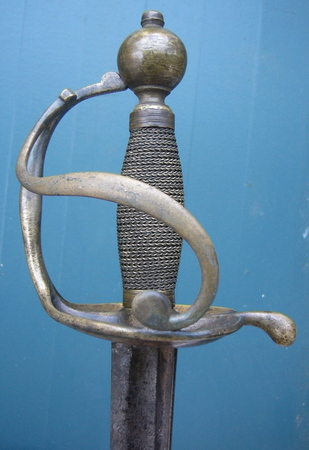VIVE LE ROY! A French and Indian War French Saber
Sold
DESCRIPTION
This sword recently surfaced in California in the hands of a general line antique dealer with no particular provenance. It is a French saber ca. 1750 with a number of elements paralleled in documented examples of the French and Indian War. For the hilt see an excavated example from Fortress Louisbourg pictured on page 125 of Rene Chartrand's recent French Military Arms and Armor in America 1503-1783, identified as ca. 1744-1758 and likely from a sword belonging to a Cannonier-Bombardier. For the overall configuration, see also the full-length saber with scabbard shown on the bottom of page 124 also identified as belonging to a Cannonier-Bombardier and also recovered from Fortress Louisbourg. (I show both of these in my photos.) In both cases, the branch of service is based on the recovery location, but they show the form being used in America.
This example measures 39 7/8 inches overall with a 33 1/8 inch blade. The blade is single edged with a double fuller: a narrow fuller running along the upper edge to within 7 inches of the tip and a broader central fuller running to 3 inches from the tip. The tip has a false, upper edge running back about 7 inches as well. The blade is engraved on both sides for the first 9 inches from the guard. Both sides feature the motto "VIVE LE ROY" above a floral motif. On the outboard side a trophy of arms surmounts the motto and above that is an arabesque of entwined flourishes. On the inboard side the royal crest of three fleurs-de-lis on an oval shield topped by a crown appears in the position of the trophy of arms and the other elements are the same. The blade is a mix of dull gray with some darker gray and brown spots, but with good edge and point, and the engraving is plainly visible. The hilt is brass, with dished double counterguard and lobed quillon, wire-wrapped grip, knuckleguard and single outboard branch, with a hallmark of a "C" surmounted by a crown struck on the inboard side of the knuckleguard. When found, the wire had sprung loose. I had it redone and a break in the outer branch at the upper end near the pommel repaired. The latter shows only a very thin lighter colored line at the join. The hilt is solid and tight.
While French small swords of the period are not uncommon, military fighting swords are scarce. This is a good example of the weapons used by French troops against the Massachusetts troops at Louisbourg and other American and British troops later. It may also have made its way as a war souvenir into the hands of Americans facing British troops a dozen years later in the Revolution. In any case, it is a scarce weapon.
Shipping $20 insured. NY addresses add sales tax.
This example measures 39 7/8 inches overall with a 33 1/8 inch blade. The blade is single edged with a double fuller: a narrow fuller running along the upper edge to within 7 inches of the tip and a broader central fuller running to 3 inches from the tip. The tip has a false, upper edge running back about 7 inches as well. The blade is engraved on both sides for the first 9 inches from the guard. Both sides feature the motto "VIVE LE ROY" above a floral motif. On the outboard side a trophy of arms surmounts the motto and above that is an arabesque of entwined flourishes. On the inboard side the royal crest of three fleurs-de-lis on an oval shield topped by a crown appears in the position of the trophy of arms and the other elements are the same. The blade is a mix of dull gray with some darker gray and brown spots, but with good edge and point, and the engraving is plainly visible. The hilt is brass, with dished double counterguard and lobed quillon, wire-wrapped grip, knuckleguard and single outboard branch, with a hallmark of a "C" surmounted by a crown struck on the inboard side of the knuckleguard. When found, the wire had sprung loose. I had it redone and a break in the outer branch at the upper end near the pommel repaired. The latter shows only a very thin lighter colored line at the join. The hilt is solid and tight.
While French small swords of the period are not uncommon, military fighting swords are scarce. This is a good example of the weapons used by French troops against the Massachusetts troops at Louisbourg and other American and British troops later. It may also have made its way as a war souvenir into the hands of Americans facing British troops a dozen years later in the Revolution. In any case, it is a scarce weapon.
Shipping $20 insured. NY addresses add sales tax.











